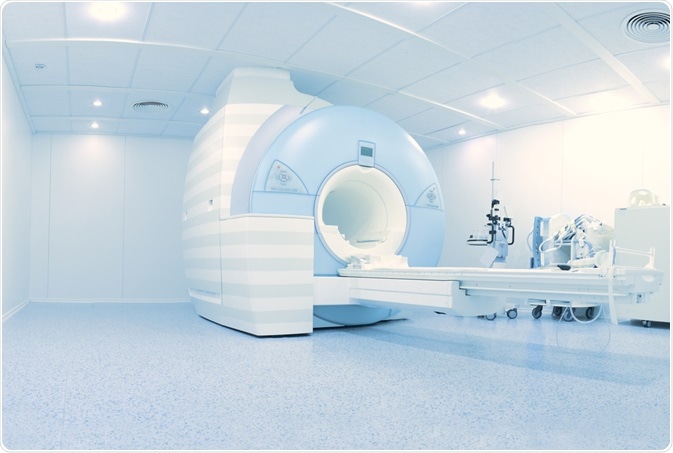Undescended testicles, otherwise known as cryptorchidism, is the most common congenital malformation and endocrine disease to occur in male infants. If left untreated, cryptorchidism can increase the likelihood that the patient experiences infertility and/or testicular cancer later in life.

Image Credit: Yeexin Richelle/Shutterstock.com
What are undescended testicles?
Undescended testicles (UT), which is used synonymously with the term cryptorchidism, is characterized as the failure of either one or both testes and their associated structures to descend during fetal development from the retroperitoneal abdomen to the scrotal sac.
As the most frequent congenital birth defects in male children, it is estimated that 2-4% of full-term male births will present with UT. In preterm neonates, the incidence of UT ranges from 1.1% up to as much as 45%, depending upon gestational age.
Causes
More often than not, the cause of UT cannot be determined. UT can occur as an isolated condition in males that do not present with any other type of congenital malformation or can appear as a co-occurring disorder in patients with other congenital malformations.
While complex in its etiology, UT is believed to be the result of a combination of factors including environmental factors, such as maternal health and exposure to endocrine-disrupting chemicals (EDCs), premature birth, or genetic predispositions, such as polymorphisms in different genes or chromosomal aberrations.
Types of UT
UT can be classified as either palpable or non-palpable testes.
Palpable UT
It is estimated that 80% of all UT are palpable and can include inguinal, ectopic, or retractile testes. Many palpable UT that are arrested in the inguinal canal are on their normal path of descent but have been halted at this location. Comparatively, ectopic UT are not on their normal path of descent and are instead located outside of the scrotum.
The term ectopic testes can therefore be used to describe any testes identified in a femoral, perineal, public, penile, or even contralateral position. Since ectopic testes have been removed from the normal pathway of descent, there is no possibility that spontaneous descent will occur. As a result, the diagnosis of ectopic testes will always require surgical intervention.
The final type of palpable UT are retractile testes, which have completed their descent into the scrotum. However, due to an overactive cremasteric reflex, the testes are also found in a suprascrotal position along the normal path of descent.
Fortunately, retractile testes can be easily manipulated to move down to their appropriate location within the scrotum. Although retractile testes are typically normal in size and consistency, it is crucial for healthcare providers to carefully monitor the patient’s testes to ensure that they do not become undescended again.
Non-palpable UT
Non-palpable testes, which make up approximately 20% of all UT diagnoses, can include intra-abdominal, ectopic, inguinal, or absent testes. Among all non-palpable testes, it is estimated that between 50 to 60% will be intra-abdominal, canalicular, or peeping.
While most intra-abdominal testes will be peeping, which indicates that they are located within the internal inguinal ring, other potential locations for this type of non-palpable testes include the kidney, anterior abdominal wall, and retrovesical space.
The second type of non-palpable testes includes absent testes, which can include the absence of a single testes, otherwise known as monorchidism, or the absence of both, which is referred to as anorchidism. Whereas 4% of all patients diagnosed with UT will have monorchidism, less than 1% are diagnosed with anorchidism.
The two pathogenic mechanisms that could be responsible for absent testes include testicular agenesis and atrophy following an intrauterine torsion.
Diagnosis
Obtaining an accurate patient history is one of the most important aspects in the diagnosis of UT. Parents with a history of hormonal exposure, tobacco smoking, and genetic or hormonal disorders may increase the likelihood that their child has UT. Additionally, a child with a previous history of descended testes that now presents with UT may indicate testicular ascent.
Once a patient history has been obtained and a general physical examination has been performed, a thorough inspection of the affected region should be conducted. During this assessment, the healthcare professional should advance their fingers along the inguinal canal towards the pubis region.
At this point in the examination, a palpable inguinal testis can be identified as a bounce beneath the examiner’s fingers. An ectopic testis is normally considered when the healthcare provider cannot identify the testis at any point along the normal path of descent during this examination.
Outside of a physical examination, certain imaging studies can assist in identifying the specific location of a UT. While limiting in their usefulness, ultrasound or magnetic resonance imaging (MRI) can be used in specific clinical situations.

Image Credit: sfam_photo/Shutterstock.com
Significance
The failure or delay to treat UT can cause the affected child to suffer from reduced fertility and/or an increased risk in testicular cancer during adulthood. Specific infertility issues that might arise in men with a history of UT can include paternity rate, semen analysis, testicular size, and altered levels of serum luteinizing hormone (LH), follicle-stimulating hormone (FSH), and/or inhibin B.
Treatment
If the testes do not naturally descend by the age of 6 months, it is highly unlikely that the UT will descend on their own. Some of the previous treatments for UT included hormone treatment with androgens, human chorionic gonadotropic (hCG), and LH-releasing hormone (LHRH).
However, these therapies alone proved to be insufficient in their ability to bring testes to the scrotal position. Therefore, the combination of hormone treatment with orchidopexy, which is the surgical procedure that moves the undescended testes to its appropriate location within the scrotum, has been found to increase testosterone levels and the number of adult spermatogonia.
In addition to these long-term benefits, early treatment of UT with orchidopexy has been found to reduce the degradation of spermatogenic tissue, and the reduction in spermatogonia as compared to when UT is left untreated.
References and Further Reading
- Urh, K., Kolenc, Z., Hrovat, M., et al. (2018). Molecular Mechanisms of Syndromic Cryptorchidism: Data Synthesis of 50 Studies and Visualization of Gene-Disease Network. Frontiers in Endocrinology 9(425). doi:10.3389/fendo.2018.00425.
- Radmayr, C., Dogan, H. S., Hoebeke, P., et al. (2016). Management of undescended testes: European Association of Urology/European Society for Pediatric Urology Guidelines. Journal of Pediatric Urology 12(6); 335-343. doi:10.1016/j.jpurol.2016.07.014.
- Hutson, J. M., & Clarke, M. C. C. (2007). Current management of the undescended testicle. Seminars in Pediatric Surgery 16(1); 64-70. doi:10.1053/j.sempedsurg.2006.10.009.